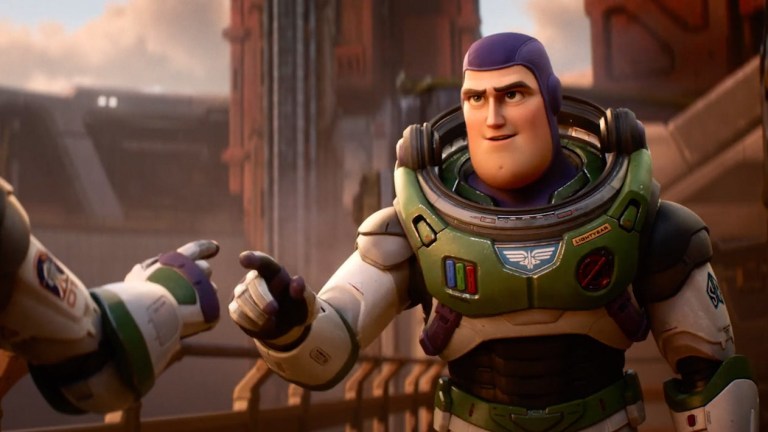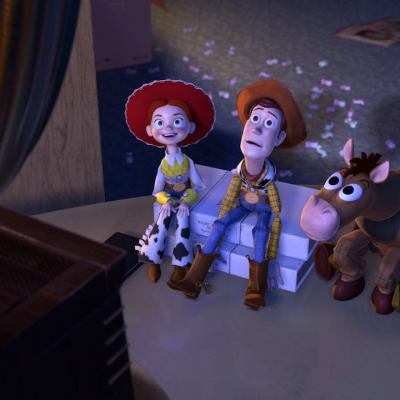Lightyear: Why Buzz Needed a New Voice and New Look
Exclusive: The creators of Pixar's Lightyear discuss their own history with Toy Story, and why they needed to change things up when telling THE Buzz Lightyear story.

In 1995 a boy named Andy received a toy for his birthday: Buzz Lightyear, Space Ranger. The toy had electronic parts, flashing lights, and far more catchphrases than the cowboy, which had previously been Andy’s favorite toy. And in a movie where toys come to life, Buzz Lightyear didn’t realize he was a toy at all, believing he was a real Space Ranger, stuck on a strange new planet. For Toy Story fans, this is a tale that’s been familiar for two decades—but what fans have never gotten to experience is Andy’s favorite movie, the film that inspired the toy.
But what if they could see that film? What if Buzz Lightyear, rather than being a toy, truly was a Space Ranger? What would that story be like? Those questions inspired the team at Pixar to launch into a new adventure: creating a space opera that at once evoked the sensibilities of the films of Andy’s (and the filmmakers’) youth while also being the best movie they could make for a modern audience. Lightyear was born.
For director Angus MacLane, the idea of exploring Buzz’s origin gave him a chance to go back to his own life-changing film inspiration: Star Wars.
“After I saw Star Wars in the theater… all I wanted to do was play Star Wars,” MacLane says. “Star Wars was just the beginning of a whole string of science fiction classics that defined my childhood. Every year, it seemed like there was another genre-defining classic.”
While Lightyear isn’t held back by the special effects of the 1970s and 1980s, MacLane and the Pixar team still wanted to capture the aesthetics of that era. They also wanted to evoke real aerospace design, so the team went to NASA to experience what astronauts had touched and used in space flight.
“We really wanted the look of our models to be such that you’d want to reach out and touch them and start playing with all the buttons and switches,” explains sets art director Greg Peltz. “A basic rule of thumb on our movie is there are no touchscreens or cloudsharing in the world of Lightyear. It’s all Zip disks and 20-pound CRTs.” In the film, there’s also a lovely callback to a familiar video game system that required players to blow air into the game cartridges to get them to work. The graphics and special effects are a product of modern animation technology, but the way the setting is imagined goes back to the heart of the era that inspired it.
For instance, Galyn Susman’s interest in space science formed during this period. She originally went to college as a physics major, hoping to one day be an astronaut before falling in love with computer graphics instead. After working for Apple in the 1980s, she started with Pixar in 1995 as a lighting supervisor and modeling artist on Toy Story. She’s become a legendary Pixar filmmaker, known as the woman who single-handedly saved Toy Story 2 when the film’s files were deleted from the Pixar computers because she had a copy at home. Now, as the producer on Lightyear, she got to revisit her dream by going to NASA, guided by astronauts Tom Marshburn and Kjell Lindgren.
“Being able to go to NASA was an exceptional experience. I was over the moon,” she tells us (acknowledging her own space pun). In describing the team’s visit to NASA to explore, she emphasizes the number of buttons and switches the team saw in the machines that had been used in real space exploration. “Being able to sit in the capsule and touch the knobs and the dials that astronauts touched… that was pretty exciting,” Susman continues. The film emphasizes the tactile nature of all of Buzz’s equipment as a way to welcome viewers into the world and give them a sense that everything there is meant to be handled and interacted with in a physical rather than digital way. (Marshburn later took a photo of the Pixar team with him to the ISS.)
The sets and aesthetic of Lightyear are meant to be tangible, and the plot-central science is based on real concepts, such as Einstein’s theory of relativity, where time moves more slowly for people traveling at faster speeds (as Buzz Lightyear will do). However, the heart of the movie—like in all Pixar films—is rooted in the characters. One of the core missions for the team was to create a Buzz Lightyear who was not comic relief.
“It was important to differentiate our hero Buzz from the toy based on his character and represented in the Toy Story movies,” Susman explains. To do that, they decided it was important to choose a new voice actor. “He needed to have a nice, rich sound, able to be both dramatic and comedic, and most importantly, he needed to be heroic without coming off as arrogant or dense. That’s a tall order, and we immediately knew we had to ask Chris Evans.”
Making that sort of change and bringing to life a new version of an established character also meant reaching out to the original voice actor, Tim Allen. “We have a great relationship,” Susman says. “He’s a part of the Disney family overall. We reached out and explained the circumstances and the thinking. Long before we put any press out there about what this film was, there was information that we were doing a Lightyear film. Of course, he would wonder why he wasn’t included! We wanted to make sure he knew what was going on.”
The Pixar team also took strides in inclusion and diversity among the cast, including an interracial, same-sex married couple. “Though it’s the film Andy saw, we were still making it for today’s generation,” Susman explains. A same-sex kiss, which had been deleted, was restored to the film, much to the satisfaction of the creative team. That relationship is a counterpoint to Buzz’s own journey in act one: while Buzz is on a mission, moving ahead in time to test new flight technology, his best friend is living her life, experiencing all the milestones Buzz is missing.
This leads to a signature Pixar moment sure to have adult viewers, at least, in tears from the poignance of loss. “There’s something funny about the notion that Pixar movies are engineered to make you cry,” says MacLane. “The reality of it is based around trying to get your audience on board with the protagonist, and what they’re going through and the choice that they’ve made.”
“We’re not actually trying to make you cry,” promises Susman, even as she concedes she’s satisfied if that’s the audience’s response. “We are trying to connect with the audience emotionally, as well as creating something that’s visually compelling and a nice story…. You want to feel what your characters are feeling, the excitement and the pain.”
The filmmakers also had to adapt to the hurdles of making the movie during the pandemic. But the experience did enable both Susman and MacLane to get in-the-moment feedback from their children (both young, in MacLane’s case, and grown, in Susman’s), who were present in their work in a way they couldn’t be while working in the office. (It was also quite different from Susman’s famous experience of working from home, which enabled her to save Toy Story 2. Lightyear, by contrast, requires so much more data that it would be impossible to store it on a single computer—and enhanced security protocols have made it impossible for anyone to accidentally delete the film.)
The sense of isolation that Buzz feels in the film will be newly familiar to audiences who have had to spend time away from their families and friends over the past few years. And the sense of a return to an era of space adventures, of soft-boiled sci-fi, is exactly the right kind of escape.
Lightyear hits theaters and IMAX screens on June 17.

